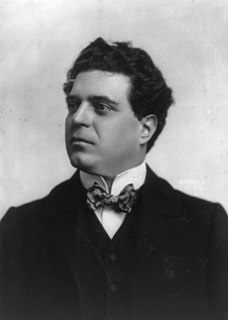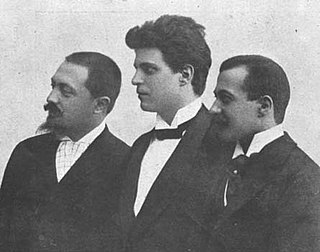
Pietro Mascagni was an Italian composer primarily known for his operas. His 1890 masterpiece Cavalleria Rusticana caused one of the greatest sensations in opera history and single-handedly ushered in the Verismo movement in Italian dramatic music. While it was often held that Mascagni, like Ruggiero Leoncavallo, was a "one-opera man" who could never repeat his first success, L'amico Fritz and Iris have remained in the repertoire in Europe since their premieres.

Umberto Menotti Maria Giordano was an Italian composer, mainly of operas.

In opera, verismo was a post-Romantic operatic tradition associated with Italian composers such as Pietro Mascagni, Ruggero Leoncavallo, Umberto Giordano, Francesco Cilea and Giacomo Puccini. Verismo as an operatic genre had its origins in an Italian literary movement of the same name. This was in turn related to the international literary movement of naturalism as practised by Émile Zola and others. Like naturalism, the verismo literary movement sought to portray the world with greater realism. In so doing, Italian verismo authors such as Giovanni Verga wrote about subject matter, such as the lives of the poor, that had not generally been seen as a fit subject for literature.

Fedora is an opera in three acts by Umberto Giordano to an Italian libretto by Arturo Colautti, based on the play Fédora by Victorien Sardou. Along with Andrea Chénier and Siberia, it is one of the most notable works of Giordano.

Alberto Franchetti was an Italian opera composer.
I Rantzau is an opera in four acts by Pietro Mascagni (1892), based on a libretto by Guido Menasci and Giovanni Targioni-Tozzetti, based on the play Les Rantzau (1873) by French writers Erckmann and Chatrian, after their novel (1882) Les Deux Frères.
Silvano is a dramma marinaresco or opera in two acts by Pietro Mascagni, 1895, from a libretto by Giovanni Targioni-Tozzetti, based on a novel by Alphonse Karr. It received its first performance on 25 March 1895 at La Scala, Milan. Although rarely performed today, the music is of some technical accomplishment, and when revived Silvano has been favourably received. The barcarolle from Silvano features prominently in a montage during the Martin Scorsese film Raging Bull.

Amica is an opera in two acts by Pietro Mascagni, originally composed to a libretto by Paul Bérel. The only opera by Mascagni with a French libretto, it was an immediate success with both the audience and the critics on its opening night at the Théâtre du Casino in Monte-Carlo on 16 March 1905. Mascagni himself conducted the performance. The opera had its Italian premiere on 13 May 1905 at the Teatro Costanzi in Rome.

Giovanni Targioni-Tozzetti was an Italian librettist, best known for his friendship and collaboration with the composer Pietro Mascagni. Most of his libretti were written in collaboration with Guido Menasci.

Guido Menasci was an Italian opera librettist.

Leopoldo Mugnone was an Italian conductor, especially of opera, whose most famous work was done in the period 1890-1920, both in Europe and South America. He conducted various operatic premieres, and was also a composer of operas.
Eugenio Giraldoni was an Italian operatic baritone who enjoyed a substantial international career. In 1900, he created the role of Baron Scarpia in Giacomo Puccini's Tosca.

Lina Bruna Rasa was an Italian operatic soprano. She was particularly noted for her performances in the verismo repertoire and was a favourite of Pietro Mascagni who considered her the ideal Santuzza. Bruna Rasa created the roles of Atte in Mascagni's Nerone, Cecilia Sagredo in Franco Vittadini's La Sagredo and Saint Clare in Licinio Refice's 1926 oratorio, Trittico Francescano. She also sang the role of Tsaritsa Militrisa in the Italian premiere of Nikolai Rimsky-Korsakov's The Tale of Tsar Saltan.

Giovacchino Forzano was an Italian playwright, librettist, stage director, and film director. A resourceful writer, he authored numerous popular plays and produced opera librettos for most of the major Italian composers of the early twentieth century, including the librettos for Giacomo Puccini's Suor Angelica and Gianni Schicchi.

Cavalleria rusticana is an opera in one act by Pietro Mascagni to an Italian libretto by Giovanni Targioni-Tozzetti and Guido Menasci, adapted from an 1880 short story of the same name and subsequent play by Giovanni Verga. Considered one of the classic verismo operas, it premiered on 17 May 1890 at the Teatro Costanzi in Rome. Since 1893, it has often been performed in a so-called Cav/Pag double-bill with Pagliacci by Ruggero Leoncavallo.
Pinotta is an idillio or opera in 2 acts by Pietro Mascagni from an Italian libretto by Giovanni Targioni-Tozzetti. The opera received its first performance on 23 March 1932 at the Teatro del Casinò in San Remo.

Zanetto is an opera in one act by Pietro Mascagni to an Italian libretto by Giovanni Targioni-Tozzetti and Guido Menasci. It received its first performance on 2 March 1896 at the Liceo Musicale Rossini in Pesaro. Only 40 minutes long and with cast of two singers, Zanetto was originally described by its composer as a scena lirica rather than an opera. It is set in the countryside near Florence during the Renaissance and tells the story of an encounter between a beautiful courtesan, Silvia, and a young wandering minstrel, Zanetto. The libretto was adapted from an Italian translation by Emilio Praga of François Coppée's play Le passant in which the young Sarah Bernhardt had won fame in the en travesti role of Zanetto.
Rodolfo Ferrari was an Italian conductor.

Mala vita is an opera in three acts composed by Umberto Giordano to a libretto by Nicola Daspuro adapted from Salvatore Di Giacomo and Goffredo Cognetti's verismo play of the same name. Giordano's first full-length opera, Mala vita premiered on 21 February 1892 at the Teatro Argentina. It was subsequently performed in Naples, Vienna, Berlin and Milan, and other Italian cities over the next two years. In 1897 a considerably re-worked and revised version under the title Il voto premiered in Milan. Within a few years both versions had disappeared from the repertoire. Amongst its rare modern revivals was the 2002 performance at the Teatro Umberto Giordano in Foggia which was recorded live and released on the Bongiovanni label.

Nicola Daspuro was an Italian writer, journalist, and librettist. Amongst his librettos were those for Macagni's L'amico Fritz and Giordano's Mala vita. Several of his librettos were written under the anagramatic pseudonym P. Suardon.















